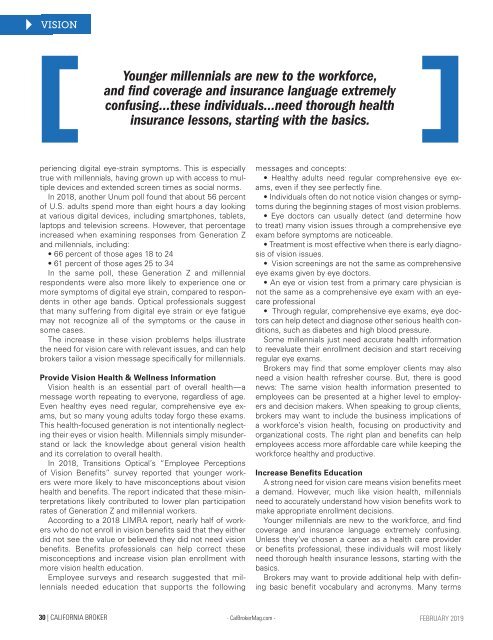CALIFORNIA BROKER Vol. 37, Number 5
Create successful ePaper yourself
Turn your PDF publications into a flip-book with our unique Google optimized e-Paper software.
LIFE VISION INSURANCE<br />
Younger millennials are new to the workforce,<br />
and find coverage and insurance language extremely<br />
confusing...these individuals...need thorough health<br />
insurance lessons, starting with the basics.<br />
periencing digital eye-strain symptoms. This is especially<br />
true with millennials, having grown up with access to multiple<br />
devices and extended screen times as social norms.<br />
In 2018, another Unum poll found that about 56 percent<br />
of U.S. adults spend more than eight hours a day looking<br />
at various digital devices, including smartphones, tablets,<br />
laptops and television screens. However, that percentage<br />
increased when examining responses from Generation Z<br />
and millennials, including:<br />
• 66 percent of those ages 18 to 24<br />
• 61 percent of those ages 25 to 34<br />
In the same poll, these Generation Z and millennial<br />
respondents were also more likely to experience one or<br />
more symptoms of digital eye strain, compared to respondents<br />
in other age bands. Optical professionals suggest<br />
that many suffering from digital eye strain or eye fatigue<br />
may not recognize all of the symptoms or the cause in<br />
some cases.<br />
The increase in these vision problems helps illustrate<br />
the need for vision care with relevant issues, and can help<br />
brokers tailor a vision message specifically for millennials.<br />
Provide Vision Health & Wellness Information<br />
Vision health is an essential part of overall health—a<br />
message worth repeating to everyone, regardless of age.<br />
Even healthy eyes need regular, comprehensive eye exams,<br />
but so many young adults today forgo these exams.<br />
This health-focused generation is not intentionally neglecting<br />
their eyes or vision health. Millennials simply misunderstand<br />
or lack the knowledge about general vision health<br />
and its correlation to overall health.<br />
In 2018, Transitions Optical’s “Employee Perceptions<br />
of Vision Benefits” survey reported that younger workers<br />
were more likely to have misconceptions about vision<br />
health and benefits. The report indicated that these misinterpretations<br />
likely contributed to lower plan participation<br />
rates of Generation Z and millennial workers.<br />
According to a 2018 LIMRA report, nearly half of workers<br />
who do not enroll in vision benefits said that they either<br />
did not see the value or believed they did not need vision<br />
benefits. Benefits professionals can help correct these<br />
misconceptions and increase vision plan enrollment with<br />
more vision health education.<br />
Employee surveys and research suggested that millennials<br />
needed education that supports the following<br />
messages and concepts:<br />
• Healthy adults need regular comprehensive eye exams,<br />
even if they see perfectly fine.<br />
• Individuals often do not notice vision changes or symptoms<br />
during the beginning stages of most vision problems.<br />
• Eye doctors can usually detect (and determine how<br />
to treat) many vision issues through a comprehensive eye<br />
exam before symptoms are noticeable.<br />
• Treatment is most effective when there is early diagnosis<br />
of vision issues.<br />
• Vision screenings are not the same as comprehensive<br />
eye exams given by eye doctors.<br />
• An eye or vision test from a primary care physician is<br />
not the same as a comprehensive eye exam with an eyecare<br />
professional<br />
• Through regular, comprehensive eye exams, eye doctors<br />
can help detect and diagnose other serious health conditions,<br />
such as diabetes and high blood pressure.<br />
Some millennials just need accurate health information<br />
to reevaluate their enrollment decision and start receiving<br />
regular eye exams.<br />
Brokers may find that some employer clients may also<br />
need a vision health refresher course. But, there is good<br />
news: The same vision health information presented to<br />
employees can be presented at a higher level to employers<br />
and decision makers. When speaking to group clients,<br />
brokers may want to include the business implications of<br />
a workforce’s vision health, focusing on productivity and<br />
organizational costs. The right plan and benefits can help<br />
employees access more affordable care while keeping the<br />
workforce healthy and productive.<br />
Increase Benefits Education<br />
A strong need for vision care means vision benefits meet<br />
a demand. However, much like vision health, millennials<br />
need to accurately understand how vision benefits work to<br />
make appropriate enrollment decisions.<br />
Younger millennials are new to the workforce, and find<br />
coverage and insurance language extremely confusing.<br />
Unless they’ve chosen a career as a health care provider<br />
or benefits professional, these individuals will most likely<br />
need thorough health insurance lessons, starting with the<br />
basics.<br />
Brokers may want to provide additional help with defining<br />
basic benefit vocabulary and acronyms. Many terms<br />
30 | <strong>CALIFORNIA</strong> <strong>BROKER</strong> - CalBrokerMag.com -<br />
FEBRUARY 2019

















